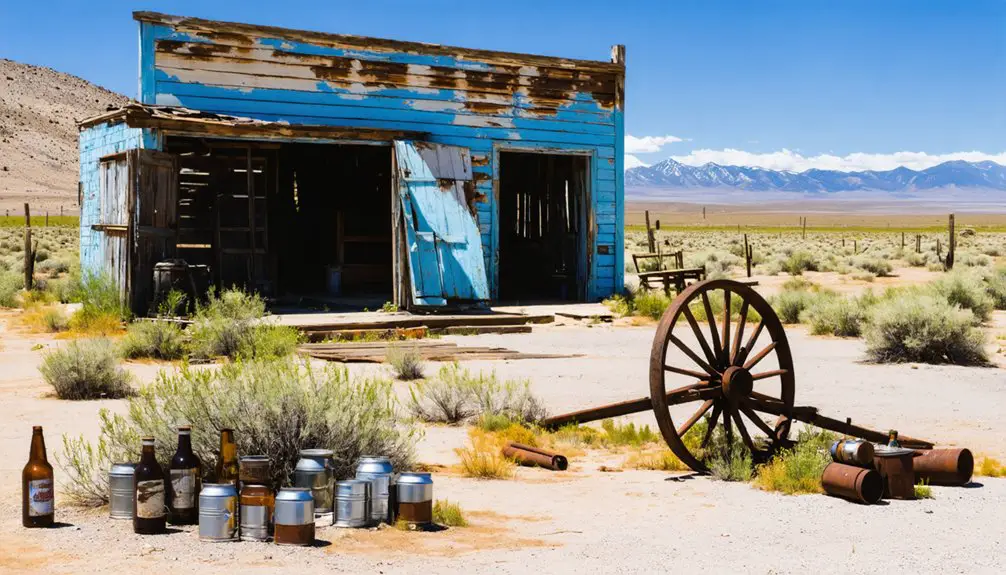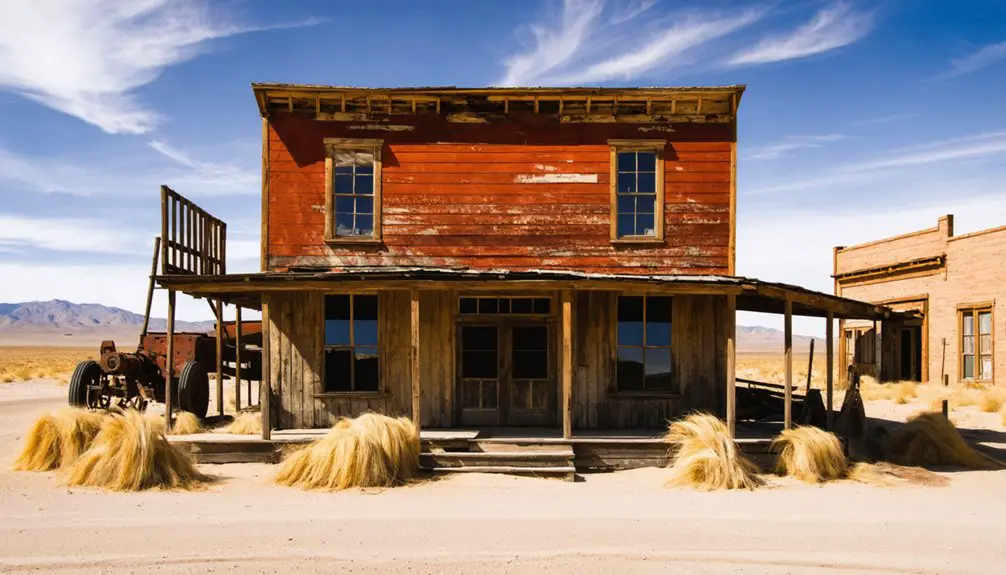You’ll find Tacoma, Nevada as a reflection of the boom-and-bust cycle of Western railroad settlements. Established in 1873 by the Northern Pacific Railroad at Commencement Bay, this maintenance stop supported about 100 residents through mining and railroad operations. While it thrived in the 1870s with saloons and general stores marking community life, improved railroad technology and the shift of operations to Montello by the 1920s led to its abandonment. Today, a solitary sign and scattered remnants reveal untold stories of Nevada’s railroad heritage.
Key Takeaways
- Tacoma was established in 1873 by the Northern Pacific Railroad as a settlement for railroad workers and mining families at Commencement Bay.
- The town’s initial population of 100 residents centered around railroad maintenance operations and mining activities in the Nevada desert.
- Environmental challenges, including water scarcity and mining contamination, combined with railroad technology advances, led to the town’s abandonment by 1920.
- Today, only scattered wooden shacks, stone walls, mining tailings, and a faded sign remain to mark Tacoma’s former location.
- The ghost town serves as an open-air museum, attracting visitors interested in Nevada’s mining heritage and boom-and-bust history.
The Birth of a Railroad Settlement
While many Western settlements emerged organically from mining or farming, Tacoma’s birth in 1873 stemmed directly from the Northern Pacific Railroad‘s strategic decision to establish its western terminus at Commencement Bay.
You’ll find the roots of this development in Job Carr’s prescient 1865 land claim of 200 acres, anticipating the railroad’s eventual arrival.
The Northern Pacific’s ambitious railroad expansion transformed the area, establishing New Tacoma to control prime real estate near the bay.
Despite financial pressures and challenging terrain, the railroad pushed forward with construction, heavily relying on Chinese labor.
This drive for economic development wasn’t without its hurdles – the first train arrived with a derailment, and Jay Cooke’s funding faced serious constraints.
Yet the railroad’s determination cemented Tacoma’s future as an essential transportation hub.
The federal land grants enabled Northern Pacific to acquire substantial territory along their routes, shaping regional development patterns.
The area’s growth was further enhanced when the Hart brothers established the Tacoma Eastern Railroad in 1890, bringing additional commerce and industry to Pierce County.
Life in Early Tacoma’s Heyday
During its brief heyday in the early 1870s, Tacoma thrived as a bustling frontier settlement of roughly 100 residents who built their lives around the rhythms of the railroad.
You’d have found a tight-knit community where railroad workers and mining families gathered at local saloons after long shifts, sharing stories of their daily struggles and triumphs.
The town’s general stores served as both commercial hubs and social centers, where residents could pick up essential supplies while catching up on local news.
Much like Virginia City’s old west spirit, Tacoma maintained its frontier character through the mining boom years.
Community gatherings often revolved around train schedules, with arrivals and departures marking the passage of time.
Life wasn’t always easy in this frontier outpost – you’d have encountered occasional bursts of Wild West violence alongside displays of remarkable resilience as residents forged a shared identity in the Nevada desert.
Like many other abandoned ghost towns in Nevada, Tacoma’s once-bustling streets now lie silent, telling stories of past prosperity.
George Wyman’s Historic Journey Through Town
As George Wyman rumbled into Tacoma on his California motor bicycle in 1902, he blazed a trail that would forever link this small Nevada settlement to America’s motorized frontier. His 1.5-hp machine, weighing just 70 pounds, represented the cutting edge of early motorized transport as he navigated through the challenging Sierra terrain. The journey was especially difficult as he encountered deep Sierra snow that forced him to push his motorcycle through treacherous conditions.
Along Wyman’s route, Tacoma served as a vital waypoint near the notorious Donner Summit. You can imagine him maneuvering through the town’s rugged landscape, seeking shelter in the railway snow sheds that protected travelers from treacherous avalanches. During his travels, he found the food at western hotels more satisfying than establishments further east.
His pioneering journey through Tacoma proved that motorized transport could conquer the Sierra Nevada’s demanding conditions, even if it meant sharing dark tunnels with trains and startling local shepherds’ flocks with his noisy contraption.
Desert Isolation and Environmental Challenges
The harsh desert environment that George Wyman briefly passed through represented a daily struggle for Tacoma’s residents. The town’s extreme isolation magnified the challenges of water scarcity, while mining contamination left a toxic legacy in the soil. Much like the Tacoma smelter site that later became Dune Peninsula Park, the area faced significant environmental contamination issues. Similar to how lead poisoning affected over a third of children in Picher, Oklahoma, the contaminated environment posed serious health risks to Tacoma’s inhabitants.
You’ll find that Tacoma’s remote location severely limited its chances for long-term survival, especially when faced with the brutal realities of desert life.
- Water supplies remained perpetually strained, forcing residents to carefully ration their usage while mining operations demanded substantial quantities.
- Temperature extremes swung from scorching days to frigid nights, wearing down both structures and spirits.
- Flash floods and dust storms regularly threatened the town’s fragile infrastructure.
- Heavy metal contamination from mining activities tainted local soils, creating hazardous conditions that persist today.
The Railroad’s Shifting Priorities
You’ll find that Central Pacific Railroad‘s original plans for Tacoma, Nevada reflected ambitious hopes for a major desert rail hub, with extensive maintenance facilities and worker housing proposed in 1868.
By the 1870s, those grand visions had shifted dramatically as the railroad concentrated its major operations in the larger settlement of Montello, about 30 miles east. This shift mirrored how freight services only would later become the focus for many rail operations. Much like the challenges faced by Chinese laborers who built significant portions of the Northern Pacific Railroad, the workforce in Nevada dealt with harsh conditions.
The reassignment of key railroad functions to Montello effectively ended Tacoma’s brief promise as a rail center, though a small water stop remained to service steam locomotives until the early 1900s.
Central Pacific’s Early Vision
During late 1860, Central Pacific Railroad‘s ambitious vision for a transcontinental rail line took shape through meticulous planning by surveyors Charles Marsh and Theodore Judah. The early planning centered on connecting California to Nevada and beyond, driven by economic opportunity and national unity.
- You’ll find the groundwork was laid in Dutch Flat, California, where initial meetings secured essential financial backing from the “Big Four” entrepreneurs.
- The strategic vision crystallized with incorporation in April 1861, establishing Sacramento as the starting point.
- Your understanding of the priorities reveals a focus on reaching key junctions like Roseville and Folsom.
- The company’s foresight emphasized thorough surveying and engineering over hasty construction, particularly for the challenging Sierra Nevada crossing.
Montello’s Railroad Takeover
While steam locomotives dominated American railroads in the early 1900s, Southern Pacific’s construction of the Lucin Cutoff in 1904 transformed the small settlement of Bauvard into Montello – a bustling division point for railroad operations.
You’ll find Montello’s railroad significance peaked as Southern Pacific moved structures, including a hotel and Chinatown, from other locations to support their expanding operations. The town’s population swelled to 800 residents as it became headquarters for Utah Construction Company and an essential service hub.
However, this prosperity wouldn’t last. A devastating fire in 1925 marked the beginning of Montello’s economic decline. By the 1940s, diesel locomotives eliminated the need for frequent maintenance stops, and Southern Pacific removed major facilities. What was once a thriving railroad center dwindled to just 75 residents.
From Bustling Stop to Abandoned Site
Although Tacoma, Nevada began as a promising railroad stop in 1869, its transformation into a ghost town exemplifies the fleeting nature of frontier settlements built around single industries.
The town’s railroad logistics initially supported about 100 residents through essential maintenance operations and community dynamics centered on the transcontinental line.
- By the 1920s, improved railroad technology made the stop increasingly obsolete.
- Nearby Montello’s rise as a preferred station drew away crucial railroad traffic.
- The harsh desert environment and remote location limited economic alternatives.
- Without railroad activity, the population gradually relocated to thriving towns.
Today, you’ll find little more than a weathered sign marking where this once-bustling stop stood, serving as a poignant reminder of how quickly frontier towns could rise and fall based on shifting transportation needs.
Legacy in Nevada’s Ghost Town Heritage

Tacoma’s transformation from railroad stop to ghost town mirrors a broader pattern in Nevada’s heritage, where hundreds of settlements rose and fell with the state’s mining fortunes.
Today, you’ll find Tacoma among the state’s vast collection of abandoned sites that tell a powerful story of western expansion and mining legacy. These remnants serve as open-air museums, preserving the raw ambition and determination of Nevada’s pioneers.
Through cultural preservation efforts, Tacoma and similar ghost towns continue educating visitors about the boom-and-bust cycles that shaped Nevada’s development.
You’re witnessing more than just abandoned buildings; you’re experiencing tangible links to the frontier era that defined the American West.
These sites now attract historians, adventurers, and tourists who seek authentic connections to Nevada’s rich mining history.
What Remains Today: A Solitary Sign
Standing sentinel in Nevada’s rugged terrain, a solitary faded sign marks all that prominently remains of the once-bustling Tacoma settlement.
A remnants analysis reveals the stark contrast between the town’s vibrant past and its current state of abandonment, where visitor experiences now center on this weathered marker amid the desert landscape.
- The sign serves as your primary navigation point, positioned near accessible dirt roads leading to the former townsite.
- Scattered wooden mining shacks and stone walls dot the surrounding Sprucemont district.
- Mining tailings and excavated pits scar the landscape, evidence of extensive past operations.
- You’ll find the area largely undisturbed, though hazardous ground conditions near old mine works demand caution.
The isolated marker stands as a poignant reminder of Tacoma’s existence, silently telling its story to those who venture into this remote corner of Nevada.
Frequently Asked Questions
Were There Any Notable Crimes or Lawlessness Incidents in Tacoma’s History?
Like most mining boomtowns, you’d find crime incidents were commonplace, with brawls and disorder in saloons, but there’s no standout notorious event. Law enforcement was minimal, leaving justice largely self-regulated.
What Happened to the Original Residents After They Left Tacoma?
You’ll find the original residents scattered to nearby towns like Montello and Goldfield, pursuing post evacuation livelihoods in mining, railroads, or trade. Historical migration patterns show they adapted to survive economic changes.
Are There Any Artifacts From Tacoma Displayed in Nevada Museums?
You won’t find specific Tacoma artifacts definitively documented in Nevada museum exhibits. While some items might be mixed into broader mining collections, there’s no clear evidence of dedicated Tacoma displays.
Did Native American Tribes Have Any Significant Interactions With Tacoma?
Powerful Paiute peoples primarily passed through this region, but tribal relations were limited. You’ll find little documented cultural exchanges beyond typical railroad-era displacement and occasional resource-gathering activities in surrounding areas.
What Natural Disasters or Extreme Weather Events Affected Tacoma’s Development?
You won’t find specific records of flooding impacts or drought challenges directly affecting Tacoma, though nearby Nevada mining towns faced these issues. Regional desert conditions likely created hardships, but didn’t determine Tacoma’s fate.
References
- https://nevadamagazine.com/issue/november-december-2019/11696/
- https://findingnevadawild.com/goldfield-the-old-west-lives-in-nevadas-best-ghost-town/
- https://www.youtube.com/watch?v=jrGDUtXfJf8
- https://nevadamagazine.com/issue/winter-2024-2025/25048/
- https://savingplaces.org/stories/explore-wild-west-mining-history-in-nevada-ghost-towns
- https://www.historylink.org/file/9389
- https://www.jobcarrmuseum.org/blog/the-railroad-comes-to-commencement-bay
- https://www.tacomahistory.org/media/dynamic/files/272_Vol13_No1_Winter2009.pdf
- https://www.historylink.org/File/22845
- https://www.tacomarail.com/about/history/



